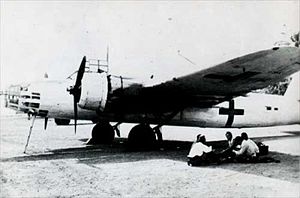Nakajima Ki-49
| Ki-49 Donryu | |
|---|---|
 |
|
| A Nakajima Ki-49 Donryu bomber of the Hamamatsu Army Heavy Bomber School | |
| Role | Heavy bomber |
| Manufacturer | Nakajima Aircraft Company |
| Designer | Yasushi Koyama |
| First flight | August 1939 |
| Introduction | 1941 |
| Retired | 1945 |
| Primary user | IJA Air Force |
| Produced | 1941-1944 |
| Number built | 819 |
The Nakajima Ki-49 Donryu (中島 キ-49 呑龍?) "Storm Dragon" was a twin-engine Japanese bomber aircraft of World War II. Despite its official designation as Army Type 100 Heavy Bomber, the requirements of the Ki-49 – to operate unescorted, with heavy defensive armament and armor – restricted it to a small bomb load (initially 1,000 kg (2,200 lb).
A mid-wing, cantilever monoplane of all-metal construction, the Ki-49 was one of the first Japanese aircraft fitted with a retractable tailwheel. During World War II, it was known to the Allies by the reporting name "Helen".
The Ki-49 was designed to replace the Mitsubishi Ki-21, which entered service in the Imperial Japanese Army Air Force in 1938. Learning from service trials of the Ki-21, the Army realized that however advanced it may have been at the time of its introduction, its new Mitsubishi bomber would in due course be unable to operate without fighter escorts. As a result, the Japanese Army stipulated that its replacement should have the speed and defensive weaponry to enable it to operate independently.
The prototype first flew in August 1939 and the development programme continued through three prototypes and seven pre-production aircraft. This first prototype was powered by a pair of 708 kW (950 hp) Nakajima Ha-5 KA-I radial engines, but the next two had the 932 kW (1,250 hp) Nakajima Ha-41 engines that were intended for the production version. Seven more prototypes were built, and these completed the test programme for the aircraft. Eventually in March 1941, the Donryu went into production as the Army Type 100 Heavy Bomber Model 1.
...
Wikipedia
